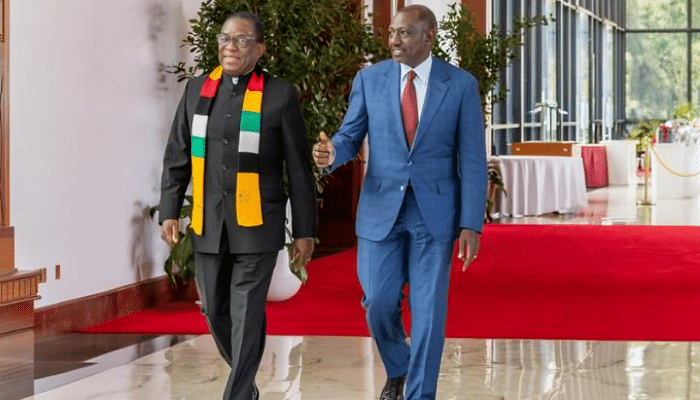
Regional Leaders Consolidate Peace Framework for DRC Crisis
In a significant diplomatic shift, two of Africa’s leading regional blocs—East African Community (EAC) and Southern African Development Community (SADC)—have agreed to merge their peace efforts for the Democratic Republic of Congo (DRC) under the coordination of the African Union (AU). The decision was made during a high-level summit in Nairobi, with the objective of eliminating overlapping peace initiatives and accelerating meaningful outcomes on the ground.
The new framework will integrate the EAC and SADC peace initiatives into a unified structure, coordinated by the AU and headquartered in Addis Ababa.
Joint Mediation Panel and Secretariat to Guide Future Talks
Following consultations between Kenyan President William Ruto, Zimbabwean President Emmerson Mnangagwa, and regional peace envoys, the summit resolved to:
- Merge the AU Mediator with the EAC-SADC Panel of Facilitators
- Establish a joint peace secretariat led by the African Union Commission (AUC)
- Create a streamlined reporting structure to both the AU and the Joint EAC-SADC Summit
This move officially combines what were previously two distinct diplomatic tracks—the Luanda Process, led by Angola’s President Joao Lourenço, and the Nairobi Process, previously overseen by former Kenyan President Uhuru Kenyatta.
The five-member Panel of Facilitators will now work directly with AU-appointed mediator President Faure Gnassingbé of Togo. The panel includes former heads of state such as Uhuru Kenyatta (Kenya), Catherine Samba-Panza (CAR), Sahle-Work Zewde (Ethiopia), Olusegun Obasanjo (Nigeria), and Mokgweetsi Masisi (Botswana).
Congo Missing From the Table Amid New Peace Direction
Although the peace process centers on resolving instability in eastern DRC, the Congolese government was notably absent from the Nairobi summit. This comes shortly after the DRC and Rwanda signed a U.S.-mediated peace agreement, supported by both the African Union and Washington. The DRC also recently signed a declaration of principles with the M23 rebel group, which the Congolese government claims receives backing from Rwanda.
Despite these parallel developments, the Nairobi-based talks are being positioned as complementary rather than competitive. President Ruto emphasized that the AU-led effort would align with the U.S.-backed and Doha-based initiatives, rather than interfere with them.
He stated that the Nairobi process will harmonize with the Washington peace accord and the ongoing Qatar-mediated negotiations, aiming to consolidate them within an African-led roadmap.
A Unified Focus on Humanitarian and Security Challenges
Regional leaders highlighted the urgency of addressing the humanitarian and security crisis in eastern Congo. President Mnangagwa of Zimbabwe stressed that the consolidation of efforts by the AU, EAC, and SADC is critical in bringing sustainable peace to the region, which has suffered from cycles of violence and displacement for decades.
The summit also agreed to:
- Formalize a Terms of Reference for peace envoys
- Establish a permanent secretariat office to coordinate diplomatic efforts
- Launch a resource mobilization plan to support operations and reduce dependency on external donors
This marks the first time regional peace envoys will have an official base of operations, resolving past challenges with funding and logistical support.
Looking Ahead: Challenges of Coordination and Implementation
While the merger of peace frameworks signals unity, observers point out that the absence of DRC representatives and persistent distrust between regional actors may hinder immediate progress. The Luanda Process, while diplomatically successful in securing verbal commitments, failed to translate them into concrete de-escalation or conflict resolution.
AU Commission Chairperson Mahmoud Ali Youssouf, who attended the Nairobi meeting, underscored the importance of coordination and coherence. He reiterated support for the U.S.-brokered agreement and urged all stakeholders to work collectively on addressing the root causes of the conflict.
Youssouf noted that although there is renewed hope for peace, implementation remains a challenge. He called for a comprehensive approach that includes inclusive dialogue and practical mechanisms to enforce commitments.
Conclusion: A New Phase in Africa-Led Peace Diplomacy
The decision to unify East and Southern African peace processes under the African Union reflects growing regional determination to take ownership of peace and security in central Africa. While challenges remain, the creation of a single mediation structure offers the possibility of greater efficiency, accountability, and sustained progress in resolving one of Africa’s most complex conflicts.
The upcoming ratification of this unified framework by the Joint EAC-SADC Summit will be a key step in operationalizing what many hope will become a turning point for peace in the Democratic Republic of Congo.
